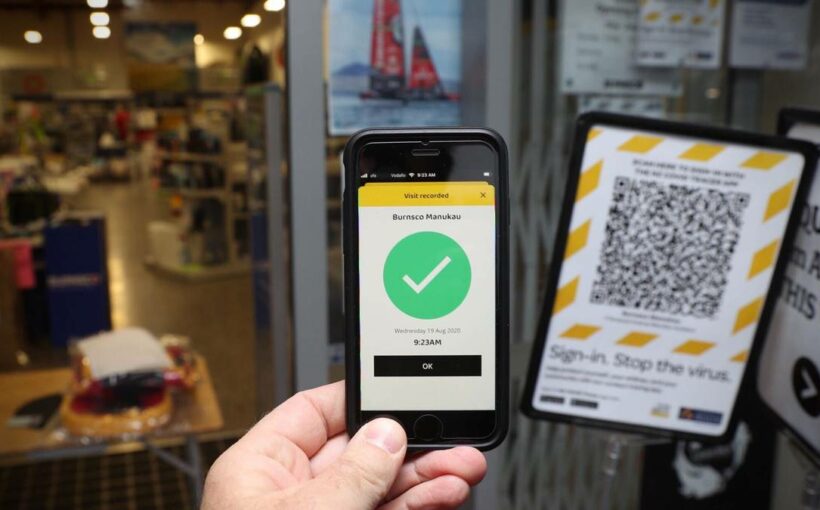New Zealanders’ lacklustre Covid-19 tracer app use means contact tracers would not be able to do their job properly if an outbreak occurred today.
The number of daily scans – QR code and manual entries – has fallen since its peak of 2.5 million in September to around 500,000 in recent weeks.
Ministry of Health data shows there were only 407,301 scans in the 24 hours from 1pm on Saturday, January 9 – the most recent day available.
University of Auckland research fellow with Koi Tū: The Centre for Informed Futures Dr Andrew Chen says the numbers are not sufficient enough.
“Keeping a record of where you have been is a preventable action and so waiting for there to be a community outbreak and then starting to scan is too late,” he said.
University of Canterbury mathematician and Te Punaha Matatini modeller Professor Michael Plank says Saturday’s number is a long fall from the highs of 2020.
“It’s clear there has been a big drop off in the number of people scanning,” he said.
“This means our contact tracers will have less information to go on when we get our next community case and makes a lockdown more likely.
“Simple message: scan like your family’s lives depend on it because they just might.”
The app was launched in May 2020 and was barely used until after health officials announced there were four new community cases on August 11.
In a 24-hour period, there was a 471% increase in scans from just over 48,124 to a whopping 275,141.
Prime Minister Jacinda Ardern promptly put Auckland back into alert level 3 and the rest of the country to level 2.
The number of scans steadily increased each week, with the most in a single day coming on September 4 when there were more than 2.5 million recorded.
It was the same day Alan Te Hiko and former Cook Islands Prime Minister Joe Williams died after both men caught the virus.
The number of scans each day declined from there onwards until a slight bump in mid-November for the Auckland CBD cases.
And to start 2021, the number of scans has remained steady around 500,000 per day.
Chen says it’s a passable number of daily scans but far from ideal.
“It’s not a bad number, at this stage, especially considering back in July the numbers were only 25,000 … 500,000 is okay, not great, but okay,” he said.
Chen says fear factor is a massive driver for the skyrocketing number of scans after the August cluster and November community cases.
“There are carrot approaches and there are stick approaches,” he said.
“A lot of discussion has been around carrots of gamification or making it look nicer, that sort of thing. Carrots can help you build longer-term behaviour change.
“Stick approaches are basically fear. Fear is a really powerful motivator but it doesn’t last. That’s why we get spikes whenever there is a scare.”
People are quick to return to normal after the risk of an outbreak reduces, which can be seen in the dramatic drop off in scans each day.
Chen did not mince his words when asked if they were enough if there was a community outbreak:
“The short answer is no,” he said.
The sentiment is supported by Plank, who says tracers need to know people’s movements and track down their contacts for the previous one to two weeks.
“This will help us avoid a lockdown when we detect the next community case,” he said.
“If contact tracers can’t get hold of this information immediately we may need a lockdown to ensure the outbreak can’t spread.”
The number of daily scans over the Christmas and New Year’s period were down on previous weeks, with between 170,000 and 460,000 recorded each day.
The numbers did not surprise Chen overall, who put the reduced number down to people being less mobile than at other times of the year.
And while the scanning numbers dwarfed recent highs, Chen is encouraged by the number of people opting to turn on the Bluetooth setting which increases each day.
However,he and Plank say it’s not a replacement for scanning but rather it is a complementary action – another layer of protection.
The Bluetooth setting will only register contacts if both people have it enabled but it does not automatically record where you have been.
Plank says getting back to the historic levels of scanning is “clearly achievable”.
“More ambitiously, if we had 75 per cent of the adult population regularly scanning that would translate to about 6 million scans per day,” he said.
“We’re clearly a long way off that but aiming for this would give us a better level of protection.”
Source: Read Full Article

/cloudfront-ap-southeast-2.images.arcpublishing.com/nzme/YKX4ZLUEJWZTHR4CPYKRBPIY6I.jpg)
/cloudfront-ap-southeast-2.images.arcpublishing.com/nzme/3FJEUGG26HPRW5RFXUYCIL5A3I.jpg)
/cloudfront-ap-southeast-2.images.arcpublishing.com/nzme/7H665TXIGXN2HIHZ4HIWI4GQW4.jpg)
/cloudfront-ap-southeast-2.images.arcpublishing.com/nzme/PEQNBW6BEIJLUEPL6W67KNB2F4.png)
/cloudfront-ap-southeast-2.images.arcpublishing.com/nzme/KRIEADFHDQGQZZE753PDZCIPIM.jpg)